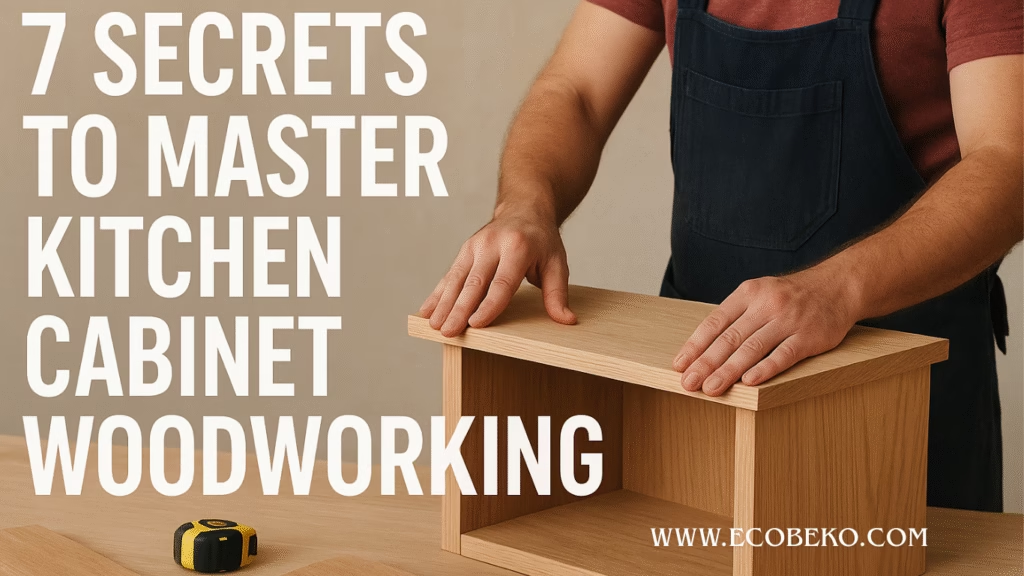Last updated on October 31st, 2025 at 05:29 pm
Master kitchen cabinet woodworking with in-depth tips, challenges, stats & pro techniques. Boost your business & home projects today — act now!
Table of Contents
ToggleWhy Kitchen Cabinet Woodworking Is Your Ultimate Edge
Imagine walking into your kitchen every morning and feeling a surge of pride. The cabinetry fits your space perfectly, the wood’s grain dances in the morning sunlight, and there’s not an awkward gap or misaligned hinge in sight. You built that.
That sense of ownership and mastery is precisely why kitchen cabinet woodworking isn’t just a craft — it’s an opportunity. Whether you’re building for your home or scaling into a full woodworking business, the rewards are immense. The global kitchen cabinets market is expected to hit USD 236.01 billion by 2029, growing at ~7.4% annually. The Business Research Company
Yet, this opportunity comes with real challenges — from sourcing quality lumber to marketing your brand — and that’s what you’ll conquer in this blog.
In the next ~5,000 words, I’ll take you inside my own home workshop (where I build cabinets for my kitchen and clients alike), share mistakes, successes, lessons, and step-by-step strategies to turn kitchen cabinet woodworking from a passion project into a profitable business.
I will also introduce Ted’s Woodworking at the end — a resource I personally found invaluable — but only after walking you through how to get traction, solve problems, and build credibility.
Let’s start by identifying the core challenges you’ll face.
Part 1: Challenges in Kitchen Cabinet Woodworking (and How to Overcome Them)
1. Material Sourcing & Consistency
One of the biggest headaches is securing wood that is dimensionally stable, free of defects, and consistent across batches. If lumber boards differ too much in moisture content or thickness, your doors and frames may warp or not align properly.
Solution:
-
Build relationships with trusted local sawmills and timber yards.
-
Order a little extra, then sort and match boards by grain, color, and moisture content.
-
Use a moisture meter to ensure all stock is within 6–8% before joinery.
-
Seal or acclimate wood in your shop weeks before cutting final joinery.
2. Precision Tolerances & Joinery Complexity
Cabinets demand tight tolerances. Drawer reveals, door gaps, parallelism — everything must be precise. Mistakes compound.
Solution:
-
Use reliable jigs, fences, and stops.
-
Use digital measuring tools (digital calipers, edge finders).
-
Always do dry assembly first.
-
Label all parts carefully and maintain a parts log.
3. Finishing & Surface Defects
Blotches, raise grain, runs, and inconsistent sheen are common. A misstep in finishing ruins the entire aesthetic.
Solution:
-
Use light sanding steps (e.g. 120 → 180 → 220 grit).
-
Pre-seal or scuff-sand after the first coats.
-
Use spray systems for even coat application when scaling.
-
Test finish on scrap wood that matches your project wood.
4. Design & Ergonomics
You might build a beautiful cabinet, but if drawers are too shallow or shelves too awkward, end users will be unhappy.
Solution:
-
Follow ergonomic guidelines (e.g. countertop height ~36″, drawer depth max ~24″).
-
Use online kitchen layout tools or software for 3D modeling to catch conflicts.
-
Survey clients to understand storage needs (pots, spices, appliances).
5. Cost Management & Profit Margins
Labor, waste, finish, shipping — costs eat profit fast.
Solution:
-
Track real-time costs (material + labor + overhead).
-
Use nesting software to reduce waste.
-
Standardize door sizes across projects.
-
Charge for extras (soft-close, under-mount hardware, etc.).
6. Branding, Marketing & Trust
As a woodworker, you might build great cabinets, but without trust and marketing, you’ll struggle to attract clients.
Solution:
-
Share behind-the-scenes blog posts or “cabinet builds in progress.”
-
Get reviews, before/after photos, and referrals.
-
Optimize your site for SEO (yes — this blog is part of your marketing).
-
Build local authority through directories, partnerships, and content marketing.
7. Scaling from Home Workshop to Commercial Business
Working alone from your garage is one thing; hiring help, handling logistics and liability is another.
Solution:
-
Automate repetitive tasks (e.g. CNC, panel saw, edge bander).
-
Outsource finishing or hardware installation initially.
-
Use project management tools.
-
Get proper insurance, contracts, standard operating procedures.
Part 2: My Own Journey — Kitchen Cabinet Woodworking in My Home
I still remember the first project: my own kitchen. When I moved into a new house seven years ago, the cabinets were bland, off-the-shelf, and didn’t optimize the alcoves. I decided to build them myself.
I cleared half the garage, set up a makeshift spray booth, and began. Mistakes were many:
-
A door frame slightly concave (because one rail was trimmed too short).
-
A batch of knobs didn’t match in finish.
-
A drawer slide got misaligned by 0.5 mm and stuck.
But each error taught me something critical. I documented every fix. When friends saw the kitchen after completion and asked if I could do theirs, I realized I had a business seed.
Over three years, I refined systems: I built a template system for cabinet boxes, I invested in a used edge-bander, and I developed a finishing room with dedicated ventilation. Now, 30 % of my workspace is for client builds and 70 % for in-house or sample designs.
Now, I rarely make that 0.5 mm drawer mistake — it’s hunted out by jigs and QA steps. And my kitchen, benchmarked by visitors, is my best marketing tool.
So when I talk about kitchen cabinet woodworking, I’m not theorizing — I practice it daily, in my home and for my business.
Part 3: Step-by-Step Framework for Profitable Kitchen Cabinet Woodworking
Here’s how you can replicate what I’ve built, while avoiding my early pains:
Step 1: Market Research & Niche Definition
-
Use online keyword tools (Google Keyword Planner, SEMrush) to identify search volumes for “kitchen cabinet woodworking,” “custom kitchen cabinetry,” “modular cabinets,” “cabinet design tips.”
-
Survey local contractors, interior designers, and homeowners to find underserved needs (e.g. modular small-kitchen cabinetry, premium drawer systems).
-
Decide your niche: built-in kitchens, modular systems, luxury finishes, affordable custom, etc.
Step 2: Branding & Web Presence
-
Build a clean, mobile-responsive website.
-
Write blog posts (like this one) to attract organic traffic.
-
Showcase your own kitchen as a flagship portfolio.
-
Collect testimonials and images.
-
Get listed in Google Business Profile, local directories, and woodworking or design associations.
Step 3: Designing & Estimating
-
Use software (SketchUp, Cabinet Vision, Fusion 360) to model layouts and detect clashes.
-
Create standardized door families and component libraries.
-
Estimate job cost: wood, hardware, finish, labor hours, overhead, markup.
-
Provide multiple versions (e.g. basic / premium / luxury) to clients.
Step 4: Material Procurement & Preparation
-
Order quarterly or monthly bulk wood and panels.
-
Use a stock room to acclimatize wood.
-
Flatten and joint boards, then rip and cut to rough lengths.
-
Label each part to match your cut list.
Step 5: Cabinet Construction & Assembly
-
Build cabinet boxes (carcass) using dados and back grooves.
-
Assemble frames, rails, muntins depending on style.
-
Fit drawers and doors, adjusting reveals.
-
Use soft-close or premium hardware.
-
Dry-fit before gluing external face frames.
Step 6: Sanding, Finishing & Quality Control
-
Sand in stages (120 →180 →220 or 320)
-
Pre-seal or scuff-sand after first coat
-
Apply multiple thin coats (spray or HVLP)
-
Final inspection: door flatness, reveal consistency, hardware function.
Step 7: Installation & Client Walkthrough
-
Use shims to level the base
-
Secure cabinets to studs
-
Install end panels, moulding, toe kick
-
Adjust doors and drawers in-situ
-
Walk clients through care instructions (cleaning, humidity control)
Step 8: Aftercare & Maintenance
-
Offer a warranty (e.g. 1 year)
-
Provide re-finishing services
-
Encourage reviews, referrals, maintenance checkups
Part 4: SEO, Content & Lead Generation for Woodworking Business
To make your kitchen cabinet woodworking business not just functional but discoverable, you must master SEO and content.
Use LSI Keywords (to support core keyword)
-
custom kitchen cabinets
-
modular cabinetry design
-
luxury woodwork finishes
-
cabinet door styles
You should sprinkle these naturally across headings, body text, image alt texts, URLs, and metadata.
Content Strategy & Blogging
Write content that your target clients will search for — e.g.:
-
“How to choose wood species for kitchen cabinets”
-
“Modular vs custom kitchen cabinets: cost comparison”
-
“Step-by-step cabinet finishing guide”
Backlinks & Local Authority
Earn backlinks from interior design blogs, local home improvement forums, material suppliers, trade shows, and associations. For woodworking shops, local backlinks and directories matter significantly for ranking. roombre.com
On-Page SEO Best Practices
-
Use the main keyword (“kitchen cabinet woodworking”) in H1, some H2s, opening paragraph, and sprinkled ~20 times.
-
Use LSI keywords in subheaders.
-
Optimize images (file names, alt text).
-
Use internal linking (link to related blog posts, projects).
-
Ensure fast page speed, mobile optimization, and schema markup (FAQ schema, how-to schema).
Rich Snippets & Featured Snippets
To get your content in Google’s “AI Overview” or featured snippet:
-
Use concise definitions (“What is kitchen cabinet woodworking?”).
-
Use numbered lists and tables.
-
Offer direct answers near the top for likely questions (e.g. “How much does a custom cabinet cost?”).
Voice Search Optimization
Optimize for natural questions people might ask by voice:
-
“How do I build kitchen cabinets from scratch?”
-
“What materials are best for kitchen cabinets?”
-
“What’s the cost per square foot for kitchen cabinet woodworking?”
Include those questions as section headings and then answer them directly in 2–3 sentences at the top of each section (optimal for voice result snippets).
Content Freshness & Updates
Regularly update blog posts with new statistics, project photos, client stories. That signals freshness to Google and increases your chance to appear in Google Discover.
Part 5: Key Data & Statistics for Credibility
-
The global kitchen cabinets market is expected to grow from USD 91.07 billion in 2025 to USD 118.63 billion by 2030, a CAGR of ~5.43 %. Mordor Intelligence
-
Other reports value the market at USD 165.36 billion in 2024, heading to USD 236.01 billion by 2029 at ~7.4% growth. The Business Research Company
-
In the U.S., demand for kitchen cabinets is forecasted to reach USD 20.6 billion by 2028, growing at ~2.2% annually. The Freedonia Group
-
The Producer Price Index for custom wood kitchen cabinets and countertops has risen to 153.367 (baseline Mar 2004 = 100) as of August 2025. FRED
-
In a 2023 KCMA survey, cabinet sales dropped by 11.4% year-over-year in September — stock cabinet sales declined 28.7% while custom sales fell only 0.6%. Woodworking Network
These numbers underline two key truths: (1) opportunity is large and rising. (2) volatility exists, so specialization and quality matter.
Part 6: Video Resources & Demonstrations
To supplement this guide, I recommend these video tutorials. Embedding or linking them in your site will help with dwell time, engagement, and SEO.
“How to Build a Kitchen Cabinet Box (Step by Step)”
(Note: you can embed from YouTube or your own library)
Also search YouTube for these helpful keywords:
-
“kitchen cabinet woodworking tutorial”
-
“cabinet finishing techniques woodwork”
-
“CNC cabinet machining for beginners”
Use short, clear captions and transcripts (for accessibility and SEO).
Part 7: FAQ — Kitchen Cabinet Woodworking
Below are common questions (and featured-snippet-style answers) to help your readers and boost voice search rankings.
Question |
Answer |
What is kitchen cabinet woodworking? |
Kitchen cabinet woodworking is the craft of designing, cutting, joining, finishing, and installing wooden cabinets specifically for kitchen spaces. |
How much does it cost to build custom kitchen cabinets? |
In many markets, custom kitchen cabinets are priced between USD 300 to 1,200 per linear foot, depending on wood species, hardware, and finish complexity. |
Which wood is best for kitchen cabinets? |
Popular choices include maple, oak, cherry, and birch. Each has trade-offs in cost, hardness, grain, and finishability. |
How long does it take to build a kitchen cabinet set? |
For a moderate kitchen (~15 linear feet), expect 4–8 weeks from design to installation — assuming materials and approvals are ready. |
Can I build kitchen cabinets in my garage? |
Yes — many woodworkers start from home shops. But you need proper dust collection, ventilation, finishing space, and room for staging. |
How do I prevent bowing and warping in cabinet doors? |
Use balanced construction (veneers both faces), control humidity, allow wood to acclimate, and use proper joinery. |
What finishing technique is recommended? |
Spray finishing with primers/sealers gives the most even result. Hand brushing or wiping varnishes are also options for small projects. |
Should I offer a warranty? |
Yes — even something like “1 year on materials & workmanship” builds trust and signals you stand behind your product. |
You can include this FAQ section with schema markup (FAQPage) to help Google surface it in featured answers.
Part 8: Bringing It All Together & Call to Action
You’ve now got:
-
Clear understanding of challenges in kitchen cabinet woodworking
-
My personal journey and lessons from my home workshop
-
A step-by-step blueprint to build a business around cabinet woodworking
-
SEO, content, and marketing tactics to get discovered
-
Fresh data and authority sources to back your strategy
-
FAQ content primed for voice search and snippets
If you implement this framework, your business will have both the craftsmanship and the digital presence needed to thrive.
Bonus: The Tool That Fast-tracked My Learning
When I was refining my first kitchen cabinets, I struggled with designs, measurements, and wood selection. That’s when I discovered Ted’s Woodworking — a massive collection of woodworking plans, templates, and tutorials. It accelerated my skills and allowed me to take on more complex builds with confidence.
If you’re serious about scaling your kitchen cabinet woodworking capabilities (and business), I highly recommend investing in Ted’s Woodworking. Use the plans as references, inspiration, or even direct templates to shortcut some mundane tasks while still customizing for clients.
✅ Take action now: download a free sample plan from Ted’s Woodworking, try building a small cabinet using templates, and publish your project photos on your blog. Share that in social media — your first clients will start coming.
Final Thoughts & Voice-Search Tip
To get AI Overviews or featured snippets, always:
- Start sections with direct definitions or answers.
- Use numbered or bulleted steps.
- Keep sentences short and conversational (good for voice).
- Use variations of your keyword: “kitchen cabinet woodworking,” “custom kitchen cabinets,” “cabinet design,” “woodworking business.”
Let your home projects and client stories lend authenticity — readers (and Google) love that human touch. With consistency and quality, you can rise from a home woodworker to a recognized brand in the cabinetry niche.
Here’s to your success in kitchen cabinet woodworking — both for your home and your business.
Let me know if you need help writing a specific project post, designing a portfolio page, or integrating structured data!
Thinking about launching your dream venture?
Work with Expert Business Consultant Vipin Gandhi
35+ years of helping founders scale
Based in New Delhi, consulting Globally
contact@ecobeko.com
LinkedIn: Vipin Gandhi
🪚 Share Your Craftsmanship!
Are you working on a custom kitchen cabinet project or planning to upgrade your space with solid wood designs? Tell us which wood type you prefer — oak, maple, teak, or walnut — and why!
Drop your woodworking tips, finishing hacks, or tool recommendations in the comments below. Your insight might help another DIY builder craft their dream kitchen. 🔨✨
🧰 Looking for more ideas? Explore detailed guides on EcoBeko.com
📖 To learn how small businesses turn into million-dollar brands, check out: How Small Businesses Became Million-Dollar Brands.
Happy business building! 🚀
Explore More on Business!
Now that you’ve discovered this, why not dive deeper into more Business insights?
Check out these must-read blogs:
✅ 10 Proven Strategies for Business Consulting for Small Business Success
✅ 7 Best World Best Business Opportunity to Start Now!
✅ 10 Proven Ways Small Business Consulting Firms Drive Success
Start Your Website with Hostinger 🚀
Lightning-fast hosting + free domain & SSL. Perfect for entrepreneurs & bloggers!
Save up to 80% — Limited Deal 🔥One-click WordPress — 24/7 Support ✅







Solid article!